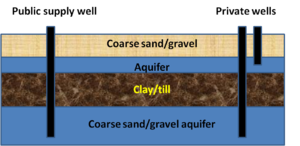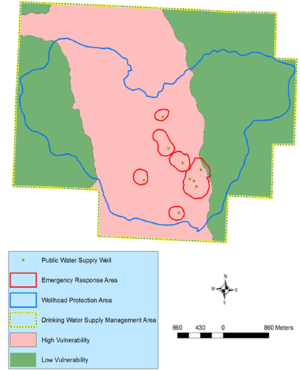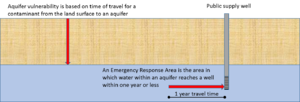
Difference between revisions of "Guidance and recommendations for conducting a higher level of engineering review for stormwater infiltration in DWSMAs and Wellhead Protection Areas"
m |
|||
| Line 71: | Line 71: | ||
Note that these recommendations are relatively conservative and professional geoscientists or engineers may utilize other methods, including modeling. | Note that these recommendations are relatively conservative and professional geoscientists or engineers may utilize other methods, including modeling. | ||
| − | {{alert|Note that private wells within a DWSMA may not be completed in the same aquifer as the public supply well. In this case, aquifer vulnerability and travel time should be determined independent of the DWSMA designations. See the | + | {{alert|Note that private wells within a DWSMA may not be completed in the same aquifer as the public supply well. In this case, aquifer vulnerability and travel time should be determined independent of the DWSMA designations. See the discussion above (Rationale for requiring a higher level of engineering review) for more information.|alert-warning}} |
==Examples== | ==Examples== | ||
This section will be developed in August 2018. | This section will be developed in August 2018. | ||
Revision as of 13:08, 20 August 2018
The Construction Stormwater Permit requires a higher level on engineering review for proposed infiltration projects in areas overlying an Emergency Response Area (ERA) where the vulnerability of the DWSMA (Drinking Water Supply Management Area) is classified as moderate, or in areas outside the ERA where the vulnerability of the DWSMA (Drinking Water Supply Management Area) is classified as high or very high. This page provide guidance and recommendations for conducting a higher level of engineering review.
Contents
Description of Emergency Response Areas, DWSMAs, and vulnerability of DWSMAs
The figure at the right illustrates protection designations used to manage public water supply wells that have wellhead protection plans.
- Drinking Water Supply Management Area (DWSMA) - the surface and subsurface area surrounding a public water supply well, including the wellhead protection area, that must be managed by the entity identified in a wellhead protection plan. This area is delineated using identifiable landmarks that reflect the scientifically calculated wellhead protection area boundaries as closely as possible.
- Drinking Water Supply Management Area Vulnerability. An assessment of the likelihood that the aquifer within the DWSMA is subject to impact from overlying land and water uses. It is based upon criteria that are specified under Minnesota Rules, part 4720.5210, subpart 3.
- Emergency Response Area (ERA). The part of the wellhead protection area that is defined by a one-year time of travel within the aquifer that is used by the public water supply well (Minnesota Rules, part 4720.5250, subpart 3). It is used to set priorities for managing potential contamination sources within the DWSMA. This area is particularly relevant for assessing impacts from potential sources of pathogen contamination because this time of travel is believed to closely correspond with the survival period of many pathogens.
- Wellhead Protection Area (WHPA) – the surface and subsurface area surrounding a well or well field that supplies a public water system, through which contaminants are likely to move toward and reach the well or well field (Minnesota Statutes, section 103I.005, subdivision 24).
A public water supply well is vulnerable if:
- the well water contains ten (10) milligrams per liter or more nitrate plus nitrite nitrogen;
- the well water contains quantifiable levels of pathogens as defined in part 7040.0100, subpart 26, or chemical compounds that indicate groundwater degradation as defined in Minnesota Statutes, section 103H.005, subdivision 6;
- the well water contains one tritium unit or more when measured with an enriched tritium detection method; or
- an enriched tritium analysis of the well water has not been performed within the past ten years; and
- information on the well construction is not available; or
- the geological material from the land surface to where the groundwater enters the public water supply well is:
- fractured bedrock;
- solution weathered bedrock;
- sandstone bedrock;
- unconsolidated material 0.062 millimeters (fine sand) or larger; or
- a combination of the materials specified in units (a) to (d).
Five classes of vulnerability exist: very low, low, moderate, high, and very high. Within high and very high vulnerability designations, contaminants at the land surface have the potential to move quickly to the underlying aquifer.
Rationale for requiring a higher level of engineering review
There are two conditions in which infiltration is prohibited under the Construction Stormwater General Permit unless a higher level of engineering review is conducted and demonstrates that a functioning treatment system will prevent adverse impacts to groundwater.
- An Emergency Response Area (ERA) within a DWSMA classified as moderate vulnerability
- Outside of an ERA within a DWSMA classified as having high or very high vulnerability
Vulnerability assessments for wellhead protection are based on data that was existing at the time of plan development, and are often reliant on stratigraphic information from construction logs for wells and borings constructed for purposes other than characterizing the nature and continuity of confining units. Therefore they should be viewed as a best estimate at the time of plan development, and subject to change during future plan amendments depending on the availability of newer or higher quality data.
In the first condition above, a contaminant will potentially be transported to an underlying aquifer within a moderate time frame (e.g. one year to a decade). The concern is that contaminants reaching an aquifer within the ERA can be transported to a public supply well within a short time (less than one year). It is therefore important to collect additional information about the geologic materials overlying the aquifer or ensure a minimal risk of contaminant exposure in these settings.

In the second condition above, outside of the ERA, the wells most likely to be impacted by infiltration practices are those also completed in the highly vulnerable aquifer and situated within one-year time of travel of the infiltration site. Determinations of ERA are based on sound geologic analysis and modeling, but other receptors beyond the public water supply well are not considered. Thus, private wells in these settings are at risk. Engineering review in this situation entails either conducting more detailed geologic analysis or modeling or conducting a well receptor survey.
Note that aquifer vulnerability for a DWSMA considers only the aquifer in which public water supply wells are located. The vulnerability designation for private wells completed in other aquifers must be determined on a case by case basis. For example, in the schematic to the right, private wells completed in the same aquifer as the public supply wells have the same aquifer vulnerability designation as the DWSMA for the public well. The private well completed in the shallow aquifer above the confining unit is likely to have very high vulnerability.
Since the CSW permit focuses only on DWSMAs and on the vulnerability designation for DWSMAs, many private wells located in aquifers other than the aquifer for the DWSMA, or private wells located outside of DWSMAs may be at risk from an infiltration practice. It is Highly recommended that receptor surveys be completed for any infiltration practice, including those outside a DWSMA and that engineering reviews be conducted when private wells are likely to be located within a year travel time of the infiltration practice. See the following section for guidance.
Guidance and recommendations for conducting a higher level of engineering review
The two conditions requiring higher levels of engineering review differ and therefore have different recommendations.
1. Condition 1: Moderate vulnerability overlying an ERA. Because there is a high degree of certainty regarding the boundaries of the ERA, the purpose of the engineering review in this case is to conduct a detailed geologic analysis or provide reasonable assurances that risk of contaminant exposure is limited.
- Detailed geologic analysis: The goal of this analysis is to determine the likelihood that contaminants will be attenuated or rapidly transported in the unsaturated (vadose) zone overlying the aquifer. Soil borings are highly recommended link here for guidance. There is no clear line defining when sufficient protective material exists in the unsaturated zone. Modifying Minnesota Department of Natural Resources guidance, we make the following recommendations.
- For non-carbonate aquifers, a minimum of 10 feet of low permeability units overlying the aquifer. The units may be aggregated (e.g. one 10-foot low permeability unit, two 5-foot low permeability units, etc.). Low permeability materials include Hydrologic Soil Group (HSG) D soils/material, clayey tills, lake clays, and shale.
- For non-carbonate aquifers, a minimum of 20 feet of moderate permeability units overlying the aquifer. The units may be aggregated (e.g. one 20-foot moderate permeability unit, two 10-foot moderate permeability units, etc.). Moderate permeability materials include HSG C soils/material.
- For carbonate aquifers, at least one continuous low permeability unit 10 feet or greater in thickness, or an aggregate of 20 feet of low permeability units.
If borings are not utilized, other sources of information may be used, but these should be used with caution. Examples include multiple well boring logs that show similar driller interpretation, or hydrogeologic assessments or studies conducted by professional organizations, such as the United States Geological Survey or Minnesota Pollution Control Agency.
An alternative approach to ensuring protection of a public water supply well is to ensure a minimum risk of contaminants exposure. This includes the following recommendations.
- Ensure there are no stormwater hotspots in the area contributing runoff to the infiltration practice.
- Ensure there are no existing contaminant sources within the area contributing to the infiltration practice. The Screening assessment for contamination at potential stormwater infiltration sites guidance may be used for this.
- Develop a spill response procedure for the area.
- Ensure there are land use controls in place to prevent introduction of contaminants sources into the future.
2. Condition 2: High and very high vulnerability outside an ERA. While a geologic assessment can be used in this situation, it is not necessary. If a geologic assessment is conducted, the goal would be to ensure there is sufficient protective material to retard contaminants before reaching the aquifer. The recommendations for conducting a geologic analysis described for condition 1 above can be used.
The primary concern for this condition, however, is to identify or protect other receptors, which typically will be private well owners. This can be achieved by limiting the risk of contaminant exposure, as described above for condition 1. A second option is to conduct a receptor survey. This is a two step process.
- Determine the one year travel time surrounding the infiltration practice. This can be estimated using simple calculators (example). For information on typical aquifer properties, link here. If the aquifer properties are unknown, assume a one mile radius around the infiltration practice.
- Determine if there are any active receptors utilizing the aquifer within the one year travel time area.
Note that these recommendations are relatively conservative and professional geoscientists or engineers may utilize other methods, including modeling.
Examples
This section will be developed in August 2018.

